A schematic diagram of the movement of the refrigerant in the air conditioning system is shown in fig. 12.2.
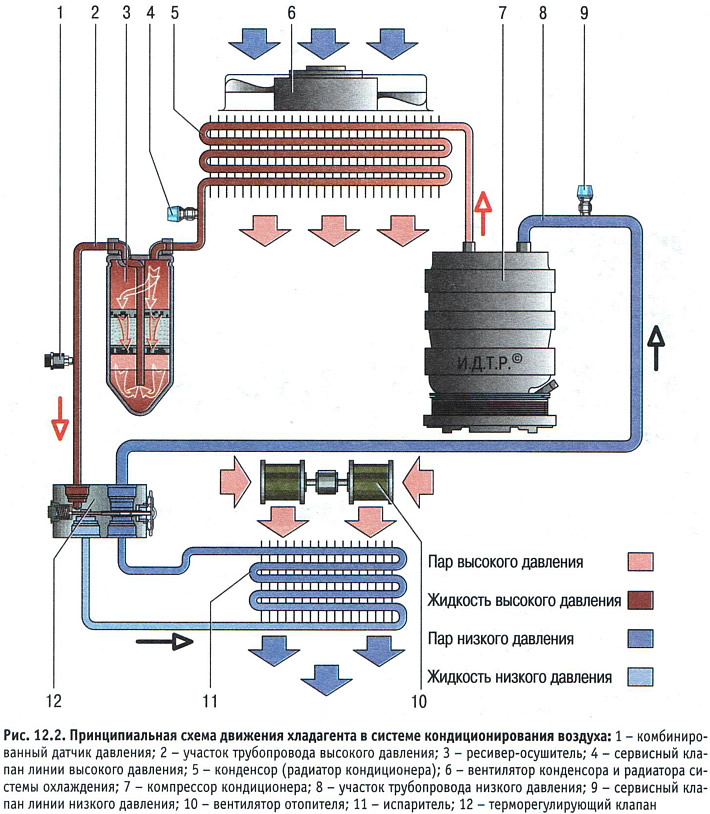
Compressor
The compressor is mounted on the engine block and is driven by a V-ribbed belt.

The compressor circulates the refrigerant in the system. The compressor shaft is installed in the aluminum front housing cover on bearings and sealed from the side of the drive pulley with an oil seal.

The compressor drive pulley is mounted on a double-row ball bearing and constantly rotates when the engine is running. Torque is transmitted from the pulley to the compressor shaft through the driven disk.
NOTES:
If the system is working properly, when the air conditioner is turned on, a click is heard - this is the clutch pressure plate, under the action of an electromagnet, engages with the drive pulley, and the compressor rotor begins to rotate.
But during the operation of the air conditioner, the following compressor malfunctions may occur.
1. If, when the air conditioner is turned off, the clutch makes extraneous sounds during rotation, heats up, or a burning smell appears, then its bearing has probably begun to collapse. In this case, the bearing must be replaced. In some advanced cases, it may be necessary to replace the compressor clutch assembly or its constituent parts.
2. If you don’t hear a click after turning on the air conditioner, then the following problems are possible:
- there was a refrigerant leak, and the control system blocks the compressor from turning on;
- the pressure sensor in the system has failed;
- malfunctions in the electrical circuits of the control system;
- the coil winding of the clutch electromagnet burned out;
- engine control unit for any reason (high engine coolant temperature, high engine speed) blocked the compressor.
3. If the clutch rotates easily and freely, but when the air conditioner is turned on, extraneous noises are clearly audible or the engine even stalls, then the compressor is most likely stuck. The internal pump part of the compressor cannot be repaired. In this case, the compressor will have to be replaced.
4. And the last, most unpleasant option. A click is heard, the clutch easily rotates the compressor shaft, and there is no cooling of the air in the cabin. In this case, the compressor runs idle, pumping nothing. Only an experienced specialist with special control and diagnostic equipment can determine this malfunction.
The cause of the malfunction can be most accurately determined after a complete diagnosis in a specialized service center for the repair of automobile air conditioners.
Condenser (air conditioning radiator)
The multi-flow type condenser is located in front of the radiator of the engine cooling system. It is attached with brackets to the radiator frame. The condenser cells are made of flat thin-walled aluminum tubes with internal longitudinal baffles for rigidity and external fins to improve heat transfer. Tanks are aluminum, with flanges for connection of pipelines and a receiver. The tanks are divided into sections along the height, therefore, passing through the condenser, the refrigerant flow changes direction several times. In the condenser, the vapors of the refrigerant compressed by the compressor are condensed and the heat released in this case is removed into the surrounding air.
When the air conditioner is turned on, the engine control unit turns on the power supply circuit for the electric fan of the engine cooling radiator, which improves heat transfer in the condenser and reduces pressure in the air conditioner system.

USEFUL ADVICE: At least once a year, preferably before the start of summer operation, wash the fins A of the condenser cells from adhering dirt, dust and anti-icing agents B. This will improve heat transfer, reduce pressure in the system and increase the service life of the system elements.
Do not use high pressure water jets to clean the condenser. This may cause damage to the B thin-walled fins. Even with regular washing, the need to replace the condenser occurs much more often than we would like. The fact is that he is the first to take on the flow of anti-icing reagents, dirt and pebbles from the road. And its tube walls are thin... In most cases, the condenser is damaged by corrosion in the third or fourth year of operation.
If the tightness of the condenser is broken as a result of corrosion, then it is more expensive to repair it. Even if the master of argon welding manages to patch the hole, a leak may soon appear elsewhere. By the way, the pressure in the system on hot days can reach up to 25-28 bar.
In addition, the complex structure of the condenser tube should be taken into account: along it is divided into channels by partitions, so it is highly likely that after welding, some of the channels will be blocked. Accordingly, the dissipated power will drop and the operation of the air conditioner will deteriorate, especially in traffic jams and in hot weather.
After each experiment with condenser patching, you will need to pay for removal-installation, welding of the condenser and charging the system with refrigerant. So it is better to immediately install a new condenser. Instead of an expensive original one, it is quite possible to buy a cheaper condenser from authorized spare parts manufacturers.
Evaporator
The evaporator is located in the cabin heating and air conditioning unit. The evaporator is made of aluminum tubes with external fins to improve heat transfer. Passing through the evaporator tubes, the boiling refrigerant actively absorbs heat from the air blowing over the outer finned surface of the tubes. The air is cooled and blown into the vehicle interior by a fan.

NOTE: When the air passing through the evaporator is cooled, the water vapor contained in it condenses. Condensate drains through the drain pipe located on the lower part of the left side of the engine shield, under the bottom of the car. If the ambient humidity is high, a puddle of water may form under the car, which is an indirect sign of the health of the air conditioning system.
WARNING: During the operation of the vehicle, particles of road dust and dirt settle on the outer surface of the evaporator that is wet from condensate.
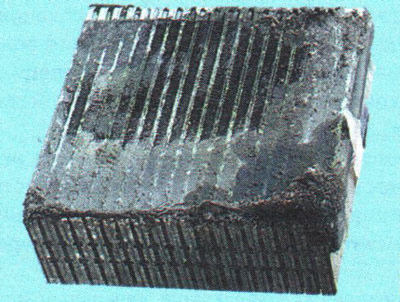
This layer becomes an excellent environment for life and rapid reproduction of putrefactive bacteria and fungal cultures. Over time, an unpleasant odor develops in the car. It is especially strong when the air conditioner is turned off and in humid weather.
In order to minimize the risk of this problem, when buying a new car, it is necessary to carry out preventive treatment of the evaporator with special chemicals, regularly replace the cabin filter and clean the drain tube. If, despite the measures taken, the smell still appears, contact a specialized car air conditioning repair service to disinfect or flush the evaporator. In case of very strong contamination, the evaporator will have to be replaced.
On the side surface of the evaporator there is a flange for mounting a thermostatic valve.
Thermostatic valve

Thermostatic expansion valve A is a block type located in the evaporator body. The valve is attached to the pipelines and the evaporator with flange connections. After passing through the throttling hole in the valve body, the liquid refrigerant abruptly reduces its pressure and begins to boil. A regulating element is installed in the valve body, which changes the flow area of the throttling hole depending on the pressure and temperature of the refrigerant. The adjusting element is adjusted at the factory and cannot be adjusted during operation.
Receiver dryer

Receiver-drier A is installed on the condenser on the left side and forms a non-separable unit with it. The filter element is inside the housing (cartridge), filled with desiccant granules (silica gel). The liquefied refrigerant passing through the receiver is cleaned of possible impurities, dirt and moisture. In the lower part B of the housing there is a hole for replacing the filter element.
WARNING: In case of repair or replacement of air conditioning system components, if it was in the open state (some units were removed, pipelines were destroyed, etc.), the receiver-dryer cartridge must be replaced. Otherwise, after charging the system, the refrigerant will not dry out and acids may form inside the system, which will destroy the parts of the air conditioner from the inside.
Pipelines
Pipelines connect all elements of the air conditioning system into a single sealed circuit. Pipelines and their fastening flanges are made of aluminum alloys.

Protect metal sections of pipelines from dents and kinks. Any narrowing of the flow area of the pipeline leads to a decrease in system performance.

To connect the mutually moving elements of the system, pipelines in some sections are equipped with flexible connectors (pic. 12.3) from synthetic materials.

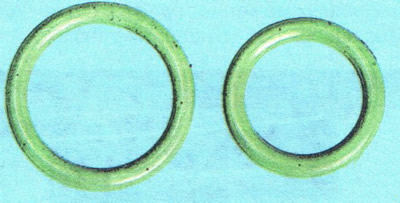
O-rings made of neoprene are installed at the joints of the individual elements of the system. During the repair of the system, when disconnecting sections of pipelines, sealing rings must be replaced. Tighten threaded pipe connections to the recommended torque. Weak or excessively strong tightening leads to deformation of the sealing surfaces and refrigerant leakage.
Service valves
Service valves for connecting diagnostic and filling equipment are located on the pipelines.
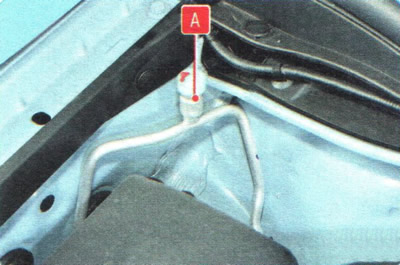
NOTE: This is how the service valves of the high A lines are located on the pipelines...

...and low B pressure.

The valves are closed with threaded caps to protect them from dirt.

The valves are equipped with spools, similar in design to the spools of the wheel tires, but differing from them in size.
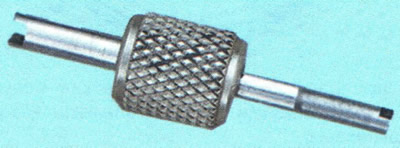
A special key is used to turn the spools in and out.

WARNING: It is forbidden to check the presence of refrigerant in the system by pressing the spools of the service valves, since after such a check the valve spool may not close completely and the refrigerant will leak from the system!
Pressure meter
The pressure sensor is installed on the flange for connecting pipelines to the compressor and is connected by a channel in the flange to the pipeline of the high pressure line.

According to the sensor signals, the electronic engine control unit turns off the air conditioning compressor in case of depressurization of the system or an emergency increase in pressure in it in order to protect the compressor from overloads.
Control unit panel
The panel of the control unit for the ventilation, air conditioning and heating system of the car is installed on the console of the instrument panel.

The controls for the heater, air conditioning and ventilation are described in detail in Sec. 1 «Vehicle device», cm. «Heating (conditioning) and ventilation».
Outside temperature sensor

The outside temperature sensor, although located at the front of the vehicle behind the grille in a sun-protected and ventilated area, is affected by factors such as warm air from the engine and radiation from hot asphalt. Therefore, his readings can sometimes be somewhat overestimated, especially after a long idle time in traffic jams. The outside temperature can be considered correct when driving at a speed of at least 40 km/h for at least 10 minutes.
Refrigerant

The system is charged with R-134a refrigerant (HFC-134a). Special oil has been added to the refrigerant to lubricate the compressor. It is strictly forbidden to use other types of refrigerants and oils in the system.
NOTES: During the operation of a car air conditioner, situations periodically arise when maintenance of the air conditioning system or its repair is required. For this, modern diagnostic and repair equipment is used. The most common situation is the depressurization of the system and the release of refrigerant from it.

Highly sensitive halogen leak detectors with sound indication are used to detect leaks.
In some difficult cases, the so-called method is used. ultraviolet diagnostics of air-conditioning system tightness.

The method consists in the fact that a special dye is introduced into the system in microdoses.
In places of microflows, the dye, together with the refrigerant, gradually comes to the outer surface of the system elements.

Dye starts to glow during system inspection (fluoresce) under the influence of ultraviolet rays of a special lamp...

...and refrigerant leaks become visible.
It should be noted that the dye does not have any negative effect on the system. It can be in the refrigerant and circulate through the system for an arbitrarily long time and serve its purpose only when a leak occurs.

After repairing the air conditioner, it is necessary to evacuate and charge the system with the appropriate refrigerant (R-134a). The volume of refueling of the car air conditioner for each car model is individual.
To carry out high-quality refueling of a car air conditioner, you need:

- precision manometric blocks with special connecting tips;

- two-stage vacuum pump for complete removal of air and water vapor from the system;

- high-precision (division value not more than 5 g) scales for dosing the charged refrigerant.
Due to the specific features of the repair of the air conditioning system, this section describes only the work on the removal and installation of individual elements and the system control unit. Work related to charging the system with refrigerant should be carried out in specialized service centers.
WARNING: The air conditioning system is charged with high pressure refrigerant. Contact of liquid refrigerant on human skin causes severe frostbite, so all work related to maintenance, repair or dismantling of air conditioning system elements should be carried out, if possible, in specialized service centers equipped with professional technological equipment. When working on your own, take precautions.
